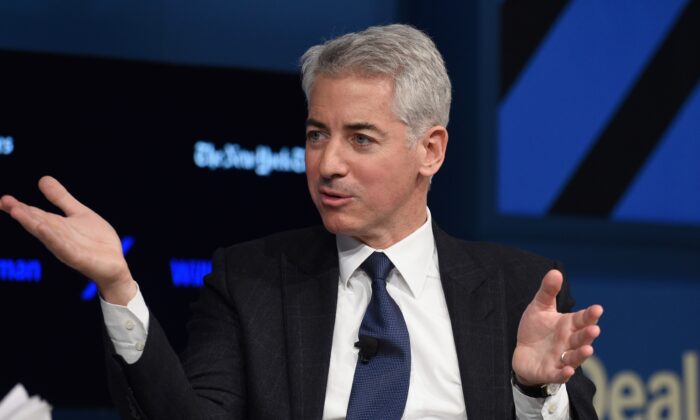Billionaire investor Bill Ackman said that the Federal Reserve’s latest decision to raise interest rates by 25 basis points, combined with Treasury Secretary Janet Yellen’s remarks that there are no plans for unlimited deposit guarantees, was a “big mistake” that puts more pressure on smaller banks and sends the economy toward a “train wreck.”
Ackman issued his warning in a series of tweets over the course of the past several days, after the Fed on Wednesday raised interest rates by a quarter of a percentage point and Yellen told lawmakers at a Senate hearing that there were no immediate plans for a broad expansion of deposit insurance to guarantee balances above the $250,000 coverage cap.
While Yellen acknowledged that there could be “reasoned discussions” on whether the $250,000 guarantee lid should be raised as part of long-run systemic reforms, a move like that would require congressional approval and she has “not considered or discussed anything to do with blanket insurance or guarantees of deposits.”
The only way to lift the deposit guarantee cap, under the current legal framework, is to declare a specific distressed bank as posing a risk to financial stability, as was done with Silicon Valley Bank (SVB) and Signature Bank, Yellen said.
Yellen’s remarks, made shortly after Fed chair Jerome Powell told a press conference that Americans’ bank deposits are “safe,” sent bank shares sliding.
‘Big Mistake’
Following the collapse of SVB and Signature, there have been calls to raise the Federal Deposit Insurance Corporation’s (FDIC) deposit cap temporarily as a confidence-boosting measure and to help stem the outflow of deposits from regional banks.
Ackman, who has called for expanded deposit guarantees, reacted to Yellen’s comment with a critical take.
“This is a big mistake. We are suffering from self-inflicted wounds,” he wrote in a tweet. Yellen’s statement, combined with the Fed’s latest interest-rate hike, “puts even more pressure” on non-systemically important banks, which is the vast majority of America’s 4,900 or so banks.
There are currently eight systemically important banks headquartered in the United States, commonly referred to as “too big to fail,” and which are subject to heightened regulatory scrutiny. This includes a requirement for them to have in place resolution plans, also known as “living wills.” The Fed and the FDIC recently reviewed these plans and deemed them adequate.
The fallout from the collapse of SVB has triggered concerns about the stability of the U.S. banking sector and led to an increased out of uninsured deposits from smaller regional banks, which have outsized roles in supporting key sectors such as commercial real estate.
The response on the part of U.S. financial authorities to the failure of SVB—and later Signature—included expanding deposit guarantees for the two institutions and opening an emergency liquidity facility where banks could borrow on easier terms to meet depositor withdrawal needs.
Blanket Coverage Expectations?
Yellen said at a conference of the American Bankers Association earlier this week that the quick response had done much to stabilize the banking system and that deposit outflows from regional banks had also stabilized. At the same time, she said reassuringly that the government is prepared to take further steps to make sure Americans’ bank deposits stay safe amid the turmoil.
“As I have said, we have used important tools to act quickly to prevent contagion,” Yellen said. “These are tools we could use again for an institution of any size if we judged its failure would pose a systemic risk.”
Many interpreted this to mean that Yellen was open to the idea of blanket deposit guarantees, setting expectations that her later statement appeared to quash.
“We have gone from implicit support for depositors to @SecYellen explicit statement today that no guarantee is being considered with rates now being raised to 5 percent,” Ackman wrote in a tweet, referring to the effective federal funds rate after the central bank on Wednesday delivered its 25 basis-point hike.
Ackman argued that a 5 percent threshhold is one that makes bank deposits “that much less attractive.”
“I would be surprised if deposit outflows don’t accelerate effective immediately,” he added.
“A temporary systemwide deposit guarantee is needed to stop the bleeding. The longer the uncertainty continues, the more permanent the damage is to the smaller banks, and the more difficult it will be to bring their customers back,” he continued.
In a later post, Ackman said that non-systemically important banks face a double whammy from higher cost of debt and deposits due to the Fed’s rate hike combined with a likely higher long-term cost of equity capital due as shareholders and bondholders reconsider their risk tolerance in light of the recent bank failures.
“Consider what the impact will be on lending rates and our economy. The longer this banking crisis is allowed to continue, the greater the damage to smaller banks and their ability to access low-cost capital,” Ackman wrote.
“Trust and confidence are earned over many years, but can be wiped out in a few days. I fear we are heading for another a train wreck,” he added.
“Hopefully, our regulators will get this right.”
Jeffrey Gundlach, head of investment management firm Doubleline, took to Twitter to predict that the Fed will be “cutting rates substantially soon.”
Investors are betting that the Fed will keep rates unchanged within the current range of 475–500 basis points when policymakers next meet in May to vote whether to hike, hold, or drop the federal funds rate in response to evolving economic and financial conditions

